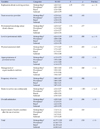Abstract
Purpose
This study aims at comparing levels of service satisfaction with and needs for visiting nurse(VN) services among their beneficiaries in order to make a plan for extending VN services.
Methods
The number of the subjects of this study is 270 in total. They were selected in random sampling in which 30 VN service recipients were randomly selected from each of 7 regions based on their grades and region types.
Results
The highest total score for satisfaction with the VN services was 46.30, which the rural residents gave to their received VN services, then the metropolitan residents gave 44.57, and the small and middle size cities' residents 43.64. On the other hand, the highest total score for needs for VN services was 33.03, which the small and middle size cities' residents gave to their received VN services, then the rural residents gave 31.68, and the metropolitan residents 30.88.
Figures and Tables
Table 1
Characteristics of Visiting Nurse Users (N=2,297)

| Level | Metropolitan | Providence | Rural | Total |
|---|---|---|---|---|
| Level I | 168 | 212 | 39 | 419 |
| Level II | 197 | 234 | 50 | 481 |
| Level III | 572 | 675 | 150 | 1,397 |
| Total | 937 | 1,121 | 239 | 2,297 |
Table 2
Characteristics Classified by Types of Service (N=270)

Table 3
Types of Service (N=270)

Table 4
Service Satisfaction (N=270)

Table 5
Types of Needs for Visiting Nurse Service (N=270)

References
1. Statistics Korea. 2014 elderly statistics [Internet]. Seoul: Statistics Korea;2014. cited 2016 January 22. Available from: http://kostat.go.kr/wnsearch/search/jsp.
2. You X, Kobayashi Y. Determinants of out-of-pocket health expenditure in China: Analysis using china health and nutrition survey data. Appl Health Econ Health Policy. 2011; 9(1):39–49. DOI: 10.2165/11530730-000000000-00000.
3. National Health Insurance Service. National health insurance statistical yearbook 2014. 1st ed. Seoul: National Health Insurance Service;2015. p. 793.
4. Lee SH, Lee DH, Jo JH. Older long-term expenditure projections medical expenses research. Research Report. Seoul: National Health Insurance Service;2015. December. Report No.: 2015-1-0004.
5. Jung WS, Yim ES. The effect on health care utilization of the non-use of beneficiaries of long-term care insurance service -around of geriatric hospital's medical cost-. J Korea Acad Ind Coop Soc. 2015; 16(11):7463–7473. DOI: 10.5762/KAIS.2015.16.11.7463.
6. Kim HS, Park JY, Kwon IS, Cho YC. Quality of life and its association with physical and mental function in the elderly people affiliated with long-term care insurance services. J Korea Acad Ind Coop Soc. 2010; 11(10):3808–3819.

7. Shin MW, Kwon IS, Cho YC. Factors related to quality of life in the rural elderly people affiliated with long-term care insurance services. J Korea Acad Ind Coop Soc. 2011; 12(2):795–804.

8. Jung WS. Effect of long-term care utilization on health care utilization of the medicaid elderly. J Korea Acad Ind Coop Soc. 2014; 15(11):6746–6755. DOI: 10.5762/KAIS.2014.15.11.6746.

9. National Health Insurance Service. Long-term care insurance statistical yearbook 2014. 1st ed. Seoul: National Health Insurance Service;2015. p. 685.
10. Kim J, Lee IS. The effects of visiting nursing services in longterm care insurance: A difference-in-difference analysis. J Korean Acad Community Health Nurs. 2015; 26(2):89–99. DOI: 10.12799/jkachn.2015.26.2.89.

11. Lee JS. Installation analysis and policy implications of the elderly long-term care facilities [Internet]. Sejong: Korea Institute for Health and Social Affairs;2015. cited 2016 January 22. Available from: http://www.kihasa.re.kr/web/publication/periodical/issue/list.do.
12. Lee JS, Han EJ, Kang IO. The characteristics and service utilization of home nursing care beneficiaries under the Korean long term care insurance. J Korean Acad Community Health Nurs. 2011; 22(1):33–44.

13. Kwoon JH, Han EJ, Kang IO. A analysis of relationships among quality, satisfaction and purchase intention perceived by home help service users. J Korean Gerontol Nurs. 2010; 30(2):355–368.
14. Kwoon JH, Han EJ, Kang IO. Elderly long-term care services satisfaction survey. Research Report. Seoul: National Health Insurance Service;2009. December. Report No.: 2009-35.
15. Lim D, Park MH. Family member's caregiving stress and satisfaction of care for patients with dementia in long term care facilities and day care centers. J Korean Acad Adult Nurs. 2010; 22(4):384–394.
16. Lee JS, Hwang RI, Han EJ. Trends in home-visit nursing care by agencies; Characteristics under the national long term care insurance system. J Korean Acad Community Health Nurs. 2012; 23(4):415–426.
17. Shin ES, Cho YC. Cognitive function and its related factors among the elderly people affiliated with long term care insurance services in rural areas. J Korea Acad Ind Coop Soc. 2011; 12(10):493–4501. DOI: 10.5762/KAIS.2011.12.11.4493.
18. Cho JH, Kim SO, Song MK, Yim ES. A study on the effectiveness of case management in elderly medicaid beneficiaries by geographic location. J Korean Public Health Nurs. 2012; 26(2):289–302. DOI: 10.5932/JKPHN.2012.26.2.289.

19. Seo DM, Kim O, Kim JH, Mun SH, Lee WJ, Ko Y. Study material for long-term care benefit provided detailed standards development. Research Report. Seoul: Ministry of Health and Welfare;2013. December. Report No.: 11-1352000-001106-01.
20. Yoon SH, Lee KS, Cho YC. Physical function and related factors in the elderly people admitted long term home care insurance. J Korea Acad Ind Coop Soc. 2013; 14(5):2238–2348. DOI: 10.5762/KAIS.2013.14.5.2338.
21. Kwak CY. The characteristics and service utilization of long term care under national basic livelihood security system. Research Report. Seoul: Ministry of Health and Welfare;2012. November. Report No.: 11-1352000-000826-01.
22. Byeon DH, Hyun HJ. Importance and performance of visiting nurse services provided under the long term care insurance system for the elderly. J Korean Acad Community Health Nurs. 2013; 24(3):332–345. DOI: 10.12799/jkachn.2013.24.3.332.
23. Kim CW. Performance analysis of long-term care insurance operations. 1st ed. Seoul: Ministry of Health and Welfare;2012. p. 86.




 PDF
PDF ePub
ePub Citation
Citation Print
Print


 XML Download
XML Download